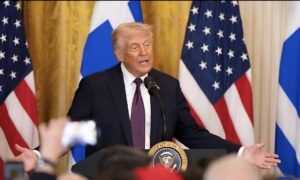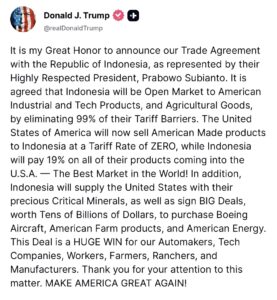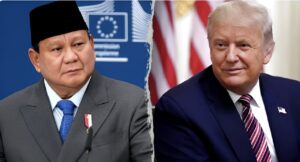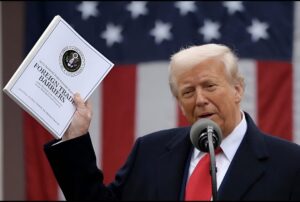As Indian and US negotiators continue their extended talks this week for an interim trade deal, US President Donald Trump announced on Tuesday that a trade agreement had been struck with Indonesia, opening that country’s markets to American businesses. He added that a similar agreement “on the same lines” was being worked on with India.
The deal with Indonesia came after what Indonesia President’s spokesperson Hasan Nasbi described as an “extraordinary struggle” by their negotiating team. As a result of the agreement, reciprocal tariffs faced by the Southeast Asian nation will be significantly reduced, dropping from 32% to 19%. In return, Trump stated that American firms would be granted “full access” to the Indonesian market.
Trump elaborated on the benefits of the Indonesian deal
emphasizing the comprehensive nature of the access gained. “We have full access into Indonesia, everything,” he told reporters. He specifically mentioned copper, noting Indonesia’s strength in the commodity, but stressed that the access extended to all sectors, with American firms paying no tariffs.
Turning to India, Trump indicated that a comparable arrangement was in the works. “India is basically working along that same lines. We’re going to have access into India,” he asserted. He underscored a perceived historical lack of market entry for American businesses in these countries, framing the current negotiations and tariff strategies as a means to rectify this. “You have to understand, we had no access to any of these countries. Our people couldn’t go in, and now we’re getting access because of what we’re doing with the tariffs,” Trump concluded, highlighting his administration’s approach to securing greater market access for US companies through trade agreements.
In a potential preview of a similar agreement with India, Indonesia has agreed to eliminate duties not only on agricultural items but also on certain manufactured goods. As part of this deal, President Trump announced that Indonesia has committed to significant purchases from the US, including $15 billion worth of US energy, $4.5 billion in American agricultural products, and 50 Boeing jets
The announcement of Indonesia’s new trade terms came swiftly after President Trump imposed a 32% tariff on the country just last week, despite ongoing negotiations. This move highlights Trump’s assertive negotiating style, where threats of increased duties are used as leverage to secure concessions.

While discussions with India have also been in progress, notably, Trump has not yet announced any new tariffs specifically targeting India. This could suggest a different dynamic at play or perhaps a strategic waiting game. According to trade experts, a potential deal with India “on the same lines” as the Indonesian agreement could lead to India significantly increasing its purchases of petroleum and agricultural products from the United States, among other goods. This mirrors the substantial commitments made by Indonesia, including purchases of US energy, agricultural products, and Boeing jets, in exchange for enhanced market access. The unfolding situation underscores the Trump administration’s consistent approach to trade deals: using tariffs, or the threat of them, to open foreign markets and boost American exports.
According to the New Delhi-based think tank GTRI, President Trump’s tendency for “unilateral declarations”such as his assertion of a “done deal” with Indonesia or his statement that India is “working along the same line”often jump ahead of the actual negotiation process. This was clearly demonstrated in the case of Vietnam, where Trump announced a 20% tariff on Vietnamese goods as part of an alleged agreement, while Vietnamese officials subsequently clarified that their understanding was only for an 11% tariff. This pattern raises concerns about the reliability and long-term stability of any trade agreements reached under such circumstances.
The think tank further emphasized that to prevent any similar misinterpretations or premature announcements, India must demand a jointly issued, written statement before officially acknowledging the terms of any agreement. GTRI stressed that verbal assurances or informal understandings, especially those conveyed via social media, are inadequate and cannot serve as substitutes for formal, verified commitments.

Moreover, GTRI raised significant “red flags” regarding President Trump’s assertion that the US will gain “full access” to the Indonesian market at zero tariffs, while Indonesian exports to the US will still face a 19% duty. The think tank warned that if India were to agree to such a disproportionate arrangement, it could severely compromise its own domestic sectors, particularly dairy and agriculture, by exposing them to duty-free US goods without securing comparable reciprocal benefits.
The GTRI note concluded by asserting that a bad deal, particularly one that unilaterally removes India’s tariffs without corresponding concessions, could ultimately be more detrimental than no deal at all. Therefore, the think tank urged India to pursue negotiations with utmost transparency, to actively safeguard against one-sided outcomes, and to resist any pressure for swift, symbolic agreements that could undermine its long-term economic interests.
Previously, it had been reported that agriculture remained a significant point of contention in the trade negotiations, largely due to India’s firm and consistent stance on protecting this sensitive sector.
The Trump administration’s strategy includes a clear threat: Indonesia deal

The United States, for its part, has clarified that the August 1 cut-off date should not be interpreted as a rigid new deadline. Instead, it is presented as an “outer limit” designed to encourage countries to “speed things up” in their trade discussions. This strategic approach, according to the US, has proven effective in motivating other trading partners, such as the European Union, to engage more actively and constructively in negotiations.
if the August 1 deadline for trade deals is not met, the affected countries will see their tariff levels revert to the higher rates announced on April 2. This pressure tactic is primarily directed at minor trading partners, as these nations largely fall outside America’s 18 most significant trading relationships, which collectively account for 95% of the U.S. trade deficit. Essentially, the administration is using the specter of increased tariffs to accelerate negotiations and secure more favorable trade terms with these smaller economies.

